Indoor hibiscus: types, planting and care
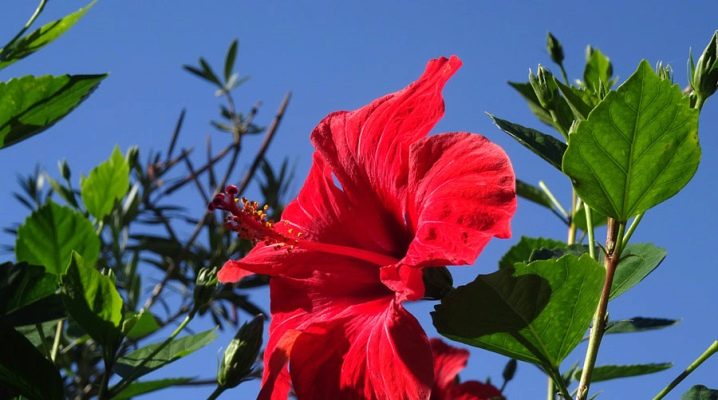
Chinese hibiscus is well known to all gardeners - it has become a real highlight of any landscape design. But few people know that there are so many varieties of this exotic that are intended for growing at home. This is a very beautiful decorative flower that, with a careful attitude, will delight its owners with abundant and long flowering.
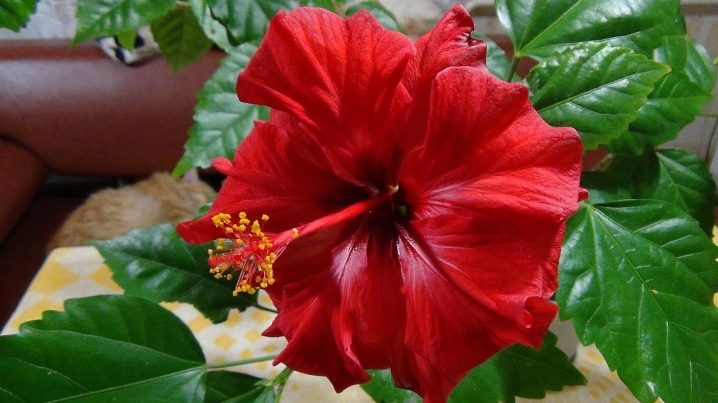
Description
Hibiscus is popularly known as the "Chinese rose". It was quite popular at the end of the last century, when it was widely bred in many apartments and private houses, but by the end of the last century, interest in culture had disappeared. However, everything is new - well-forgotten old, therefore, exotic, but very capricious flowers have already become boring for most flower growers and they remembered the undeservedly neglected favorite of our mothers and grandmothers - the Chinese rose. Hibiscus has many advantages - it blooms for a long time and profusely, it has a rather thick and decorative foliage., while unassuming to care for and easy to breed. If you provide the flower with comfortable conditions, then it will decorate your home for several decades.
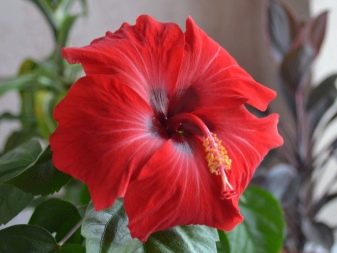

According to feng shui theories, indoor hibiscus tends to attract good and bright thoughts into the house, protect residents and absorb accumulated dark energy. Hibiscus can absorb all harmful substances from the air, thereby improving the indoor climate. Healers prepare all kinds of potions from the flowers of this unusual plant, which are used for many ailments: decoctions of the leaves treat the skin for inflammation, abscesses and complex boils. By the way, the beloved red hibiscus tea is made from this hibiscus. A decoction of its leaves helps fight high blood pressure and heaviness in the stomach.


Contrary to popular belief, hibiscus has nothing to do with Rosaceae - it is a member of the Malvaceae family. The genus of hibiscus is one of the most numerous on the globe - the number of its varieties reaches 300 varieties, they can be shrubby, as well as herbaceous and tree-like. In its natural environment, hibiscus is often found in the tropics of America, Africa, as well as in the Hawaiian and Canary Islands; some varieties of such a flower can be found in the Crimea and even in the Far East, as well as across the territory of the Caucasus. However, not all varieties are bred in houses - usually Chinese and variegated ones are grown.
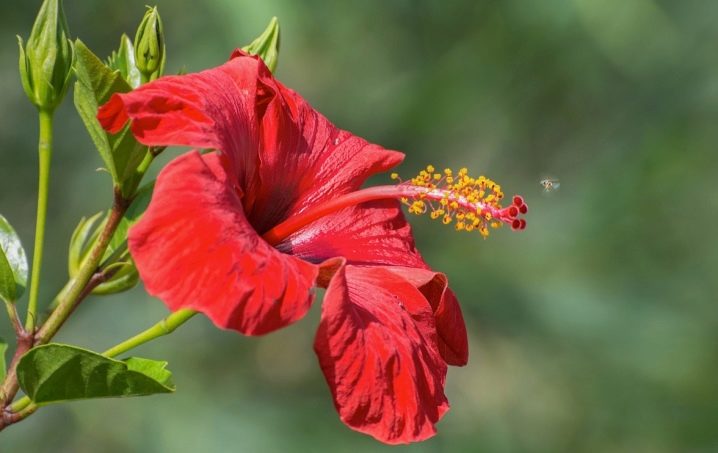
Indoor hibiscus is a small shrub, an adult plant can grow up to 3 m, the stem is covered with grayish bark. With frequent molding, it branches quite strongly. The leaves are green, maple-shaped, the length of the leaf plate is 8-10 cm. They resemble birch leaves, only larger and darker.
The flowers of home hibiscus are quite large - from 5 cm, but there are varieties with larger flowers, the diameter of which reaches 30 cm. Usually the inflorescences are simple, formed from five bent tender petals, the pistil is pubescent. There are terry varieties. The color of the petals is very diverse - white, light pink, salmon, yellow, as well as bluish and even lilac. There are even varieties that combine several shades.

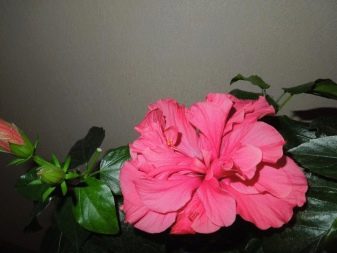
The life span of a flower is small - no more than 2 days, however, new flowers immediately bloom to replace fading flowers. This flowering lasts from 3.5 to 9 months. If you independently carry out pollination, you can get fruits. Visually, they look like a box with five small valves, inside each of which are smooth or hairy seeds. If the home hibiscus is properly looked after, then it will grow and bloom profusely for more than one decade. You can form a small tree from it or limit its growth by forming a small decorative bush.

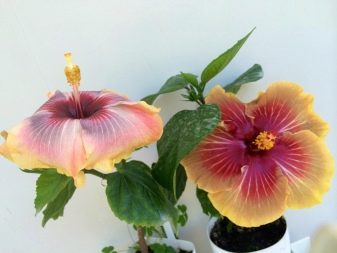
Varieties
Plants belonging to the genus hibiscus are very diverse. Some of them are bred on an industrial scale, while others are created to maintain comfort in residential apartments and office premises. In floriculture, Chinese hibiscus is the most popular. This shrub can grow up to 2.5 and even 3 m, but most often it is limited in growth. The foliage is dense, deep silty color. The flowers are quite large - their diameter is 15 cm, while flowering lasts from mid-March to October.
Scientists have bred several varieties of Chinese rose hybrids, among which the following varieties are considered the most popular:
- "Kyoto" - hibiscus with ordinary yellowish flowers, scarlet core;
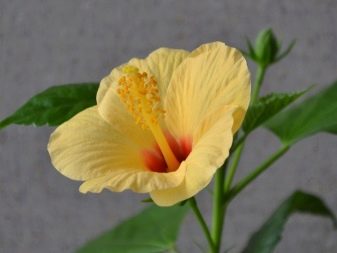
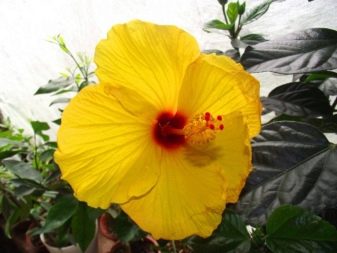
- Hamburg - has large double flowers, painted in a purple hue;
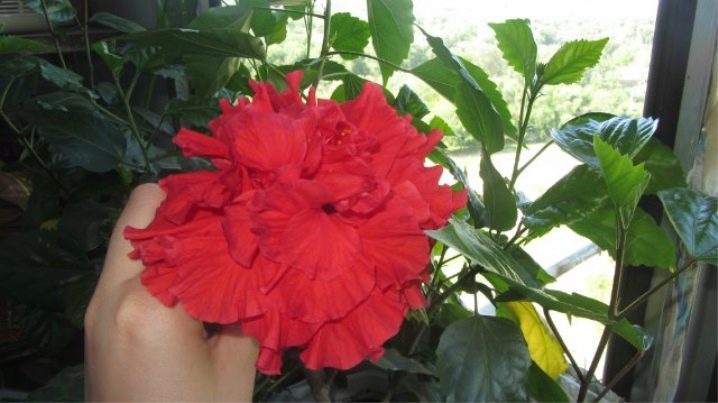
- "Florida" - the petals are quite simple in shape, the color is orange-reddish;
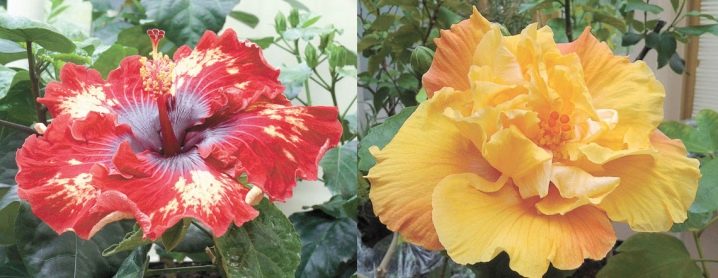
- Feeling Blue - exotic hibiscus with blue-violet flowers;
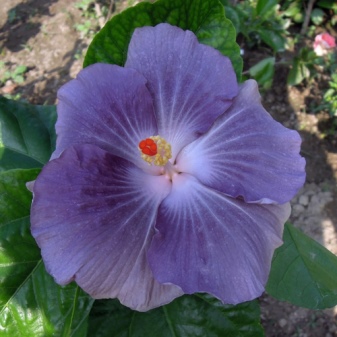
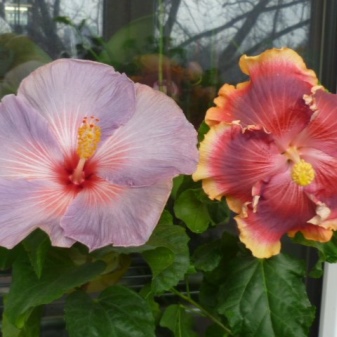
- "Parple Mazhetik" has a dark purple color of the petals, with spectacular whitish blotches, corrugated edging;
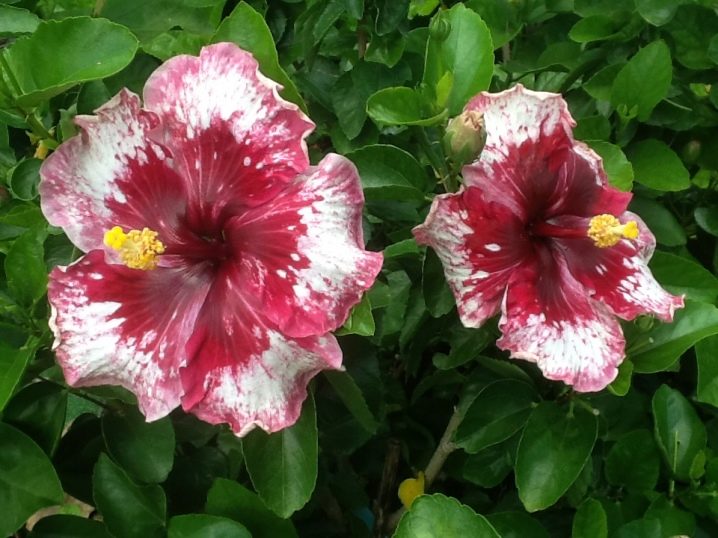
- "Carmen Keene" - flowers of extraordinary beauty of a mauve shade with a milky-whitish border;
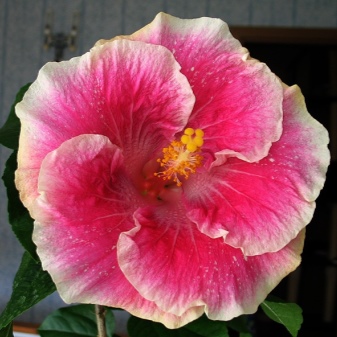

- "San Remo" - spectacular, very delicate snow-white flowers with a fluffy yellow pistil.
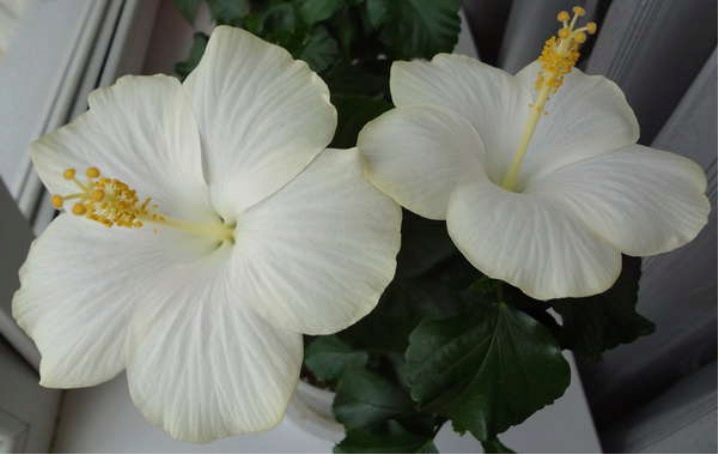
One of the most popular indoor hibiscus is the Cooper variety. He pleases his owners not only with luxurious flowers, but also with variegated leaves of bright shades. They combine the color of rich greenery and all kinds of tones of yellow, pink and white. At the same time, the color of the leaf plates is largely determined by the conditions of the plant, the structure of the soil and the parameters of illumination.
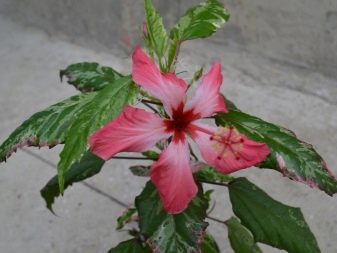

"Princess Earring" (the scientific name of this variety sounds like "Dissected") it got its unusual name due to the unusually beautiful flowers of red-orange color. Its petals are fringed and bent back, the pistil is fluffy and very long. It grows no higher than 1 meter, flowering lasts about 6 months.
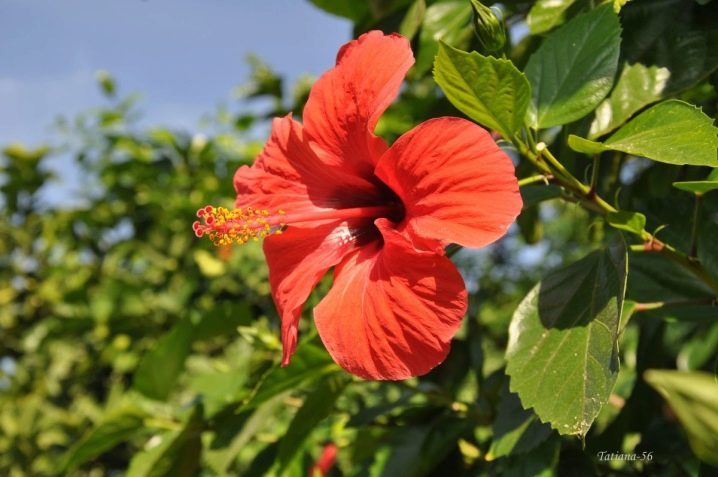
"Syrian" hibiscus is a deciduous shrub, which is often called a birch or a Syrian rose. At home - in the countries of the Middle East, as well as in Syria and China, it is cultivated as a garden plant, but we grow it as a home culture. This flower develops very slowly - the first flowers can be seen no earlier than the plant reaches 3-4 years of age. The color of the petals is purple, as well as pink, bluish and less often bluish. The foliage is very juicy, rich green.

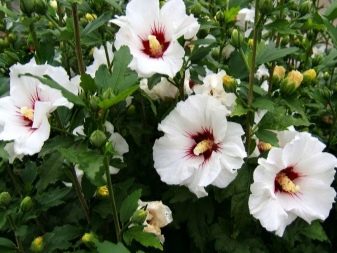
The "triple" hibiscus is grown mainly for conservatories and greenhouses, as it is annual. It is characterized by atypical rich foliage. The flowers are rather small, no more than 4 cm in diameter, the flowers are yellowish-beige, the core is burgundy.
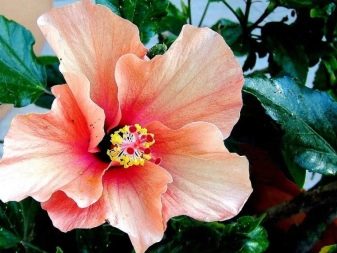
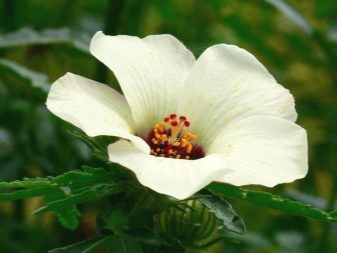
"Crazy Rose" (changeable hibiscus) can grow up to 4 m, however, not every homeowner can afford such a length, therefore the flower is artificially limited in size. In appearance, the flowers are very similar to roses, but their distinctive feature is their color. So, an unblown bud is painted in a white tone, but as it opens, the flower gradually changes its color and becomes dark crimson by the time of wilting.
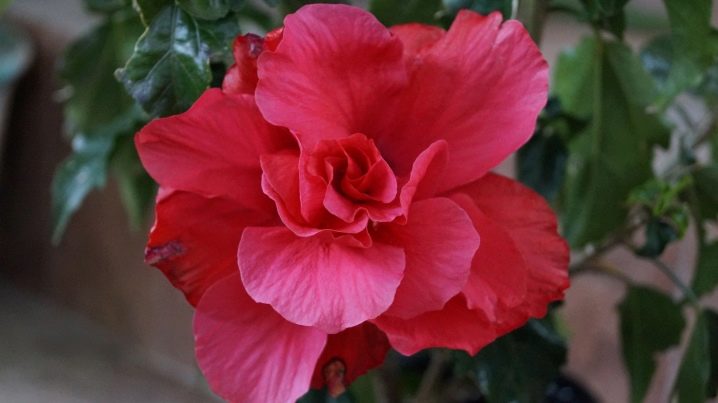
A very interesting variety of domestic hibiscus is "Okra", which is classified as edible.The pods contain a high concentration of ascorbic acid and many other beneficial vitamins. They can be dried, also pickled and even baked. Abundant flowering, flowers are orange, pinkish and yellow.
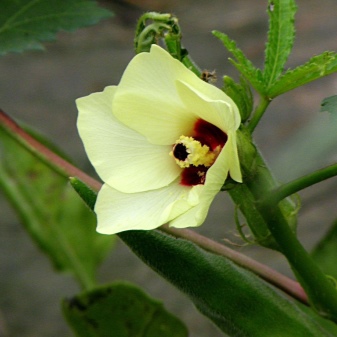
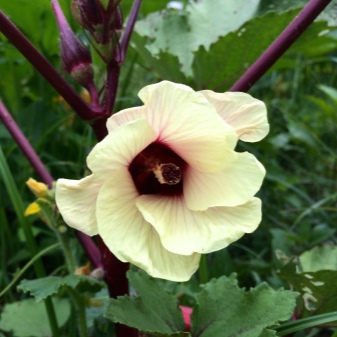
Home care
Indoor hibiscus is considered a rather unassuming culture, this bush grows extremely quickly and is almost never capricious. If you try to maintain the required temperature, constantly spray it and provide adequate lighting, it can bloom when you are not expecting it at all.
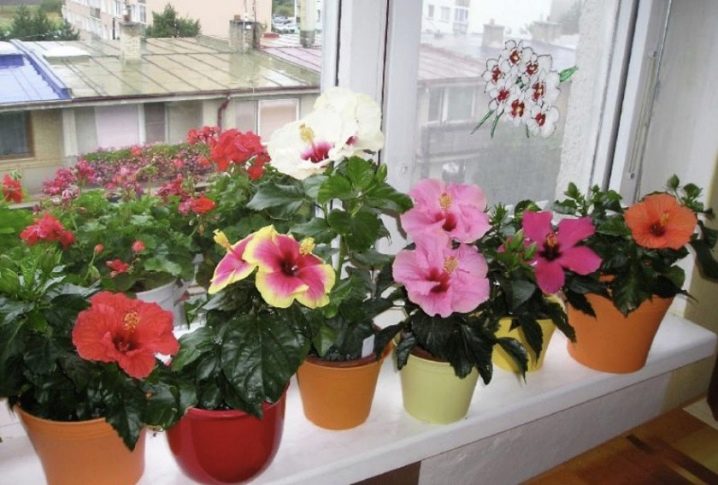
The intricacies of caring for a green pet largely depend on the season.
Spring
At this time, the hibiscus needs bright lighting, it will even benefit from a certain amount of direct ultraviolet rays. It is best to place the flower on the southeast or southwest side. If you place it on a windowsill from the southern part of the house, then at noon you need to do a little darkening with reflective film or a small paper screen. If the only possible direction is north, then additional illumination will be required here, especially in the cold season, when the daylight hours are very short.
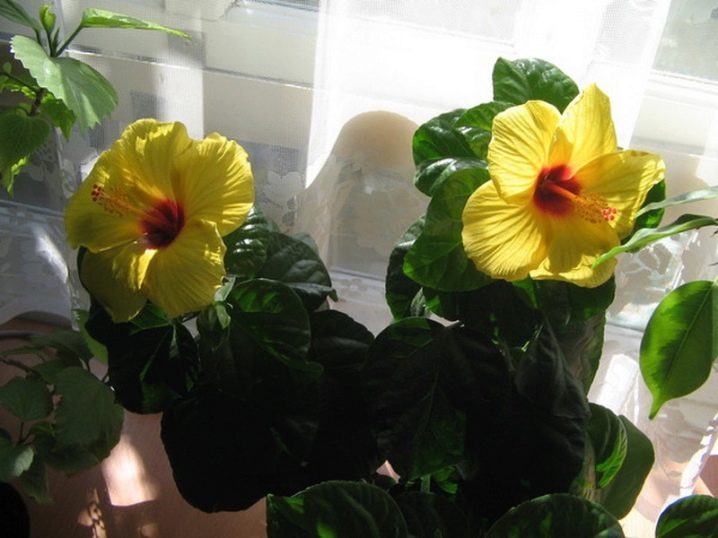
Humidity in spring is needed rather moderate - 2-3 times a week you should spray the flower with water from a spray bottle, it will also be useful to turn on a humidifier from time to time. Hibiscus does not tolerate excessively dried and hot air, so placing it near batteries and other heating devices is impractical. Hibiscus responds very negatively to sudden temperature fluctuations and drafts, so you should not keep it near an open window or a frequently opened window. The optimal temperature background during this period is 20-23 degrees above zero.
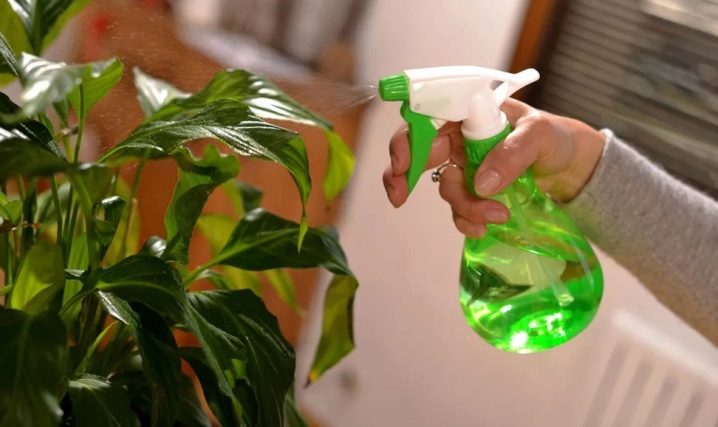
Summer
In hot weather, you can take the container with hibiscus to open areas - for example, in the garden or on the balcony. The flower is very fond of fresh air, therefore it multiplies its flowering in open areas. He needs bright lighting. You should not place the flower where semi-darkness reigns all day, but it is better to place the hibiscus in light shade, so that the ultraviolet rays do not directly touch your blooming pet. A couple of times a day in the morning and at night, it is imperative to spray the flower, otherwise the leaves can quickly fade. A comfortable temperature for him will be 25 degrees. In hotter weather, it is better to bring the pot back into the house and take it out only “for a walk”.
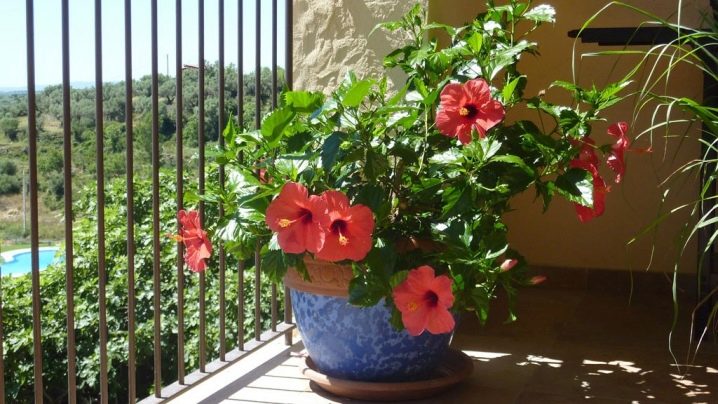
Do not forget to water the plant regularly as the earthen coma dries out, and also feed it with mineral fertilizers once every 2 weeks.
Autumn
Between September and November, the plant also needs good lighting. It is advisable to expose it to direct sunlight for several hours a day. Better to do this in the morning. In September, you can take it out into the street, and with the onset of coolness, place it for a short time on the south window. Humidity is needed average - at the level of 40-50%, occasionally the plant should be sprayed. The temperature should be kept at about 20-25 degrees, but gradually reduced to 16-18 degrees.
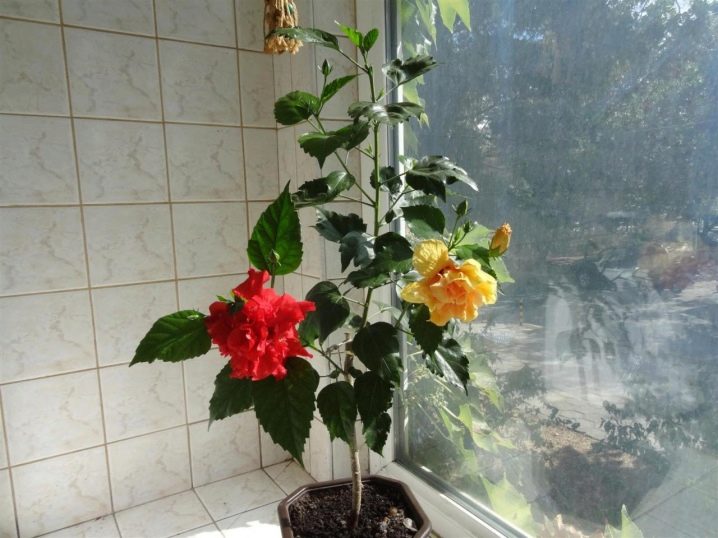
Winter
In the dormant stage, the plant, as in the rest of the months, requires the sun. If it is not enough, then take care of buying a phytolamp, which will provide the required length of daylight hours. Moderate humidity is required - 40-55%, periodic spraying is mandatory, especially with the beginning of the heating season. During this period, it is best to keep the plant in a room where the temperature is kept at around 15-18 degrees, the maximum permissible lower level is 12 degrees. If it is cold, the hibiscus will quickly shed its leaves and rot, and if the temperature is higher, the leaves will stretch and wither.
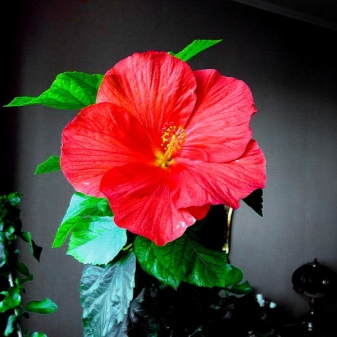
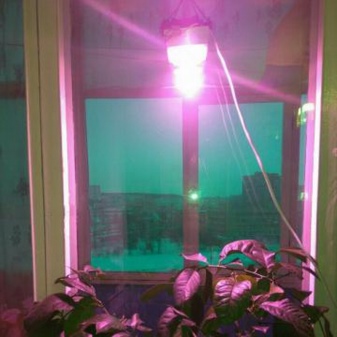
Top dressing plays a very important role in the care of hibiscus.In the spring it needs to be fertilized with potassium and phosphorus, and it is better to leave all other fertilizing for the summer, when the plant begins to bloom profusely. Keep in mind that it is better to refuse the use of nitrogen-containing preparations altogether, since the hibiscus does not like them too much.
If the conditions for the plants are uncomfortable, then one of the following problems can be observed.
- The buds form, but do not bloom and soon fall off completely. This happens if irrigation is insufficient and the substrate dries up. Other reasons can be a drop in room temperature and a lack of minerals.
- The lower leaves begin to fall off, and the new ones turn yellow almost immediately. This indicates an excessive amount of chlorine and calcium in the earth, as well as a deficiency of nitrogen and iron. In addition, too dry air and watering with too cold water can provoke the shedding of leaves.
- Lack of flowering combined with a lush dense crown. This happens when there is an overabundance of nitrogen-containing fertilizers or when there is a lack of lighting.
- Pinkish spots appear on the leaf plates - an indication of too abundant feeding and a lack of sunlight.
- Leaves wither - this happens as a result of a lack of moisture.
- Drying out of the roots indicates a lower soil temperature in the pot.
- Drying of the leaves is a consequence of waterlogging and rotting of the roots, or an excessively high air temperature in the room.
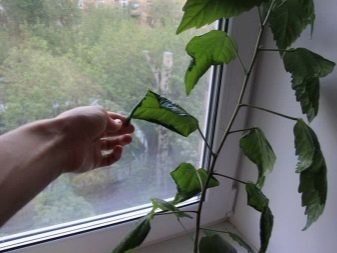
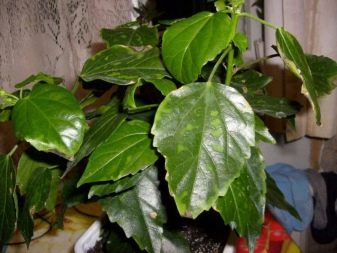
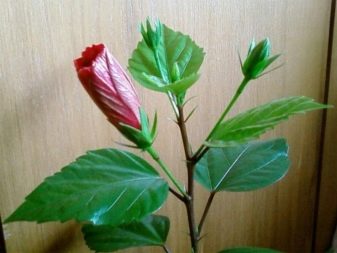
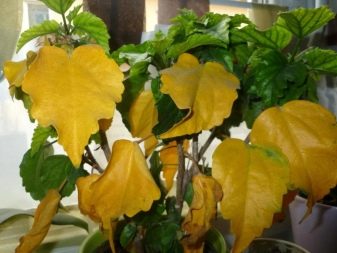
Pruning
Some growers wonder if they need to cut their hibiscus. There can be only one answer here - of course it is necessary. In addition to sanitary pruning, the plant needs crown molding. It should be carried out annually, only in this case the Chinese rose will delight you with its flowering and decorative appearance. After each flowering, all the tips of the branches must be slightly trimmed, then the ejection of lateral shoots is activated, where young buds are tied. Keep in mind that home hibiscus flowers can be made to tie exclusively on young shoots, so every branch left without pruning is minus one flower in the next season.
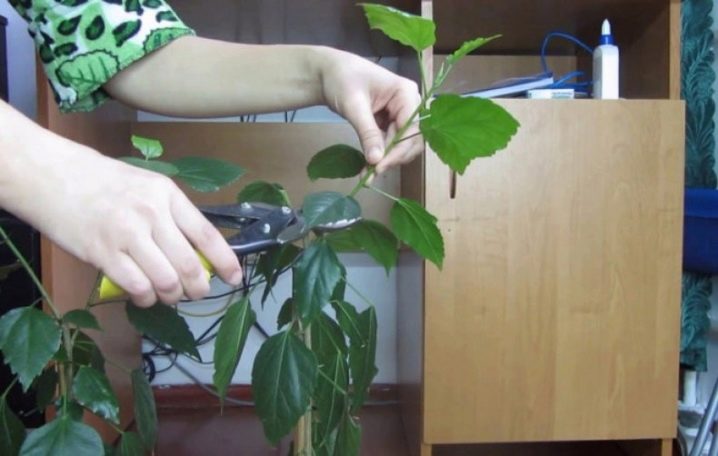
With the onset of spring, all, without exception, shoots, including new ones, should be slightly pinched. Branches that grow parallel to the main trunk, as well as inward-directed crowns, must be cut off without fail. Do not worry about your green pet - pruning always benefits him, regardless of what time of the year it is carried out.
Subtleties of transplant
Young hibiscus need to be replanted annually, while adult flowers need to be renewed every 2-3 years. For transplantation, you can take any substrate enriched with useful substances. Most often they take a mixture of garden and ready-made universal store soil in a ratio of 1 to 3. A little turf or humus will need to be added to the resulting soil mixture - and the soil is ready. If you want to make an earthen mixture completely on your own, then you can use garden soil, as well as river sand and peat in a 2: 1: 1 ratio and add a little organic matter (compost or humus) to it.

Be sure to arrange for effective drainage, otherwise the roots will begin to rot. It is best to use pebbles or expanded clay. They should be filled not less than 1/4 of the pot.
You should not choose an overly spacious container for a Chinese rose - in this case, the hibiscus will quickly grow, but will not bud. If the plant is very large, then you can limit yourself to changing the top layer of the soil mixture. If the plant is healthy, then it is transplanted by the transshipment method. Keep in mind that the fresh soil that you added to the new container usually already contains all the necessary nutrients, so you will need to fertilize the transplanted flower no earlier than 1.5-2 months after transplanting.
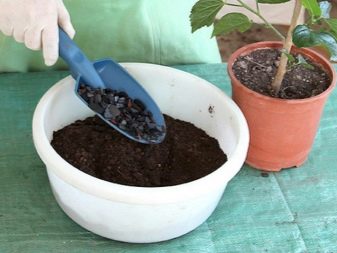
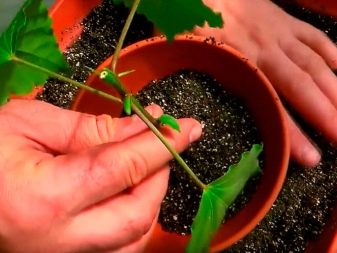
Reproduction methods
Indoor hibiscus reproduce vegetatively - by seeds or cuttings.However, the first option at home is used quite rarely, it is very long, therefore it is mainly used by breeders. If you still intend to grow hibiscus from seed, then the sequence of actions will be as follows.
- Seeds should be sown in the ground between late January and early March. Before planting, they need to be kept in the Epin solution for about 12-20 hours.
- The prepared seed material is spread on a soil consisting of peat and sand, sprinkled with prepared soil, moistened by the drip method and covered with glass or polyethylene. This is necessary to create the greenhouse effect necessary for germination and strengthening of young shoots.
- All the time until the seeds hatch, it is necessary to maintain the temperature regime near the soil at the level of 25-27 degrees. From time to time, the pot should be sure to ventilate and spray the soil with seeds.
- When the first shoots appear, the glass can be removed (first for a few hours, and after 3-4 days completely).
- As soon as the plant has 2-3 leaves, you can plant young hibiscus in a permanent place. Keep in mind that you can only wait for flowering in the second, and more often in the third year.
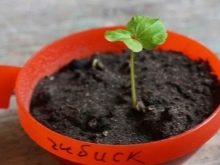

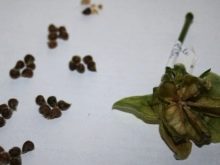
Breeding by cuttings has its advantages:
- allows you to preserve all the varietal characteristics of the mother plant;
- the seedling blooms in the first year.

In addition, reproduction with the help of shoots does not require special skills and special knowledge, therefore even a novice florist can cope with it.
The sequence of actions is as follows.
- Cuttings 10-15 cm long are cut from young branches, dried for about 2 hours and placed in a vessel with water. You also need to throw an activated carbon tablet there to prevent the formation of rot.
- From above, the container with a branch should be covered with a cut plastic bottle or bag to create a greenhouse effect.
- After about a month, roots appear - then the cuttings need to be planted in soil with a high peat content. It will be good if you add sphagnum moss to the pot - it is very useful for a young, immature plant.
- It is possible to root the cutting immediately in the ground, but in this case, infection of the shoot is not excluded, especially if the ground has not been previously disinfected.

Diseases and pests
Like any other houseplant, hibiscus often encounters disease and pest attacks. If the conditions of detention are not comfortable enough for the flower, then the development of bacterial and fungal infections is possible. Even with proper care, a florist may encounter such unpleasant "guests" as aphids, spider mites and other crop pests. The main parasites of hibiscus are spider mites - these are small whitish insects that are almost impossible to see with the naked eye - their size does not exceed 1 mm. You can understand that the plant has encountered such a dangerous enemy by the silvery cobweb and by the rapid yellowing of the foliage. The tick prefers dry places, so frequent spraying and maintaining the necessary humidity in the room will be a good prevention of its attachment. All dry leaves and shoots must be removed in a timely manner.
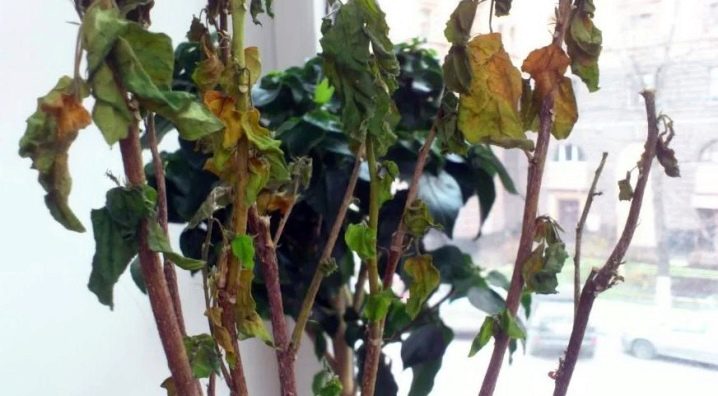
However, even such measures are sometimes insufficient and the plant is still affected by parasites. You can get rid of a spider mite with the help of special insecticidal preparations, but you can also use folk remedies. Our grandmothers, noticing a new "neighbor", first washed the plant with a solution of laundry soap, then gave it a warm shower and wrapped it with plastic wrap. Spider mites do not tolerate moisture and die rather quickly in dampness.
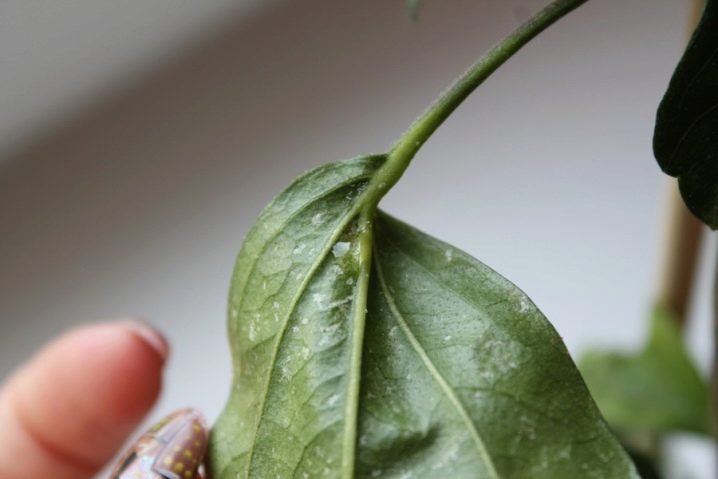
Aphids are no less dangerous for hibiscus. This insect is distinguished by a high reproduction rate.In just a month, several individuals give rise to a whole colony of pests, which feeds on the vital juices of the plant and causes its premature wilting and death. You can notice aphids with the naked eye, and sticky marks on the leaves will also make themselves felt. If there are few insects, then you can simply wash the plant with soapy water, but if there are a lot of them, then only chemical preparations and special care during the recovery period will help to save the plant. Of the diseases for hibiscus, leaf chlorosis is most characteristic. It occurs due to a violation of the thermal and irrigation regime of the plant and is manifested by a change in the color of the leaves and the appearance of brown spots on them. The buds, which do not bloom and fall off, also become a signal of an attack.
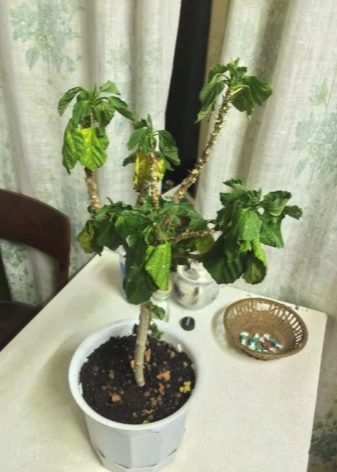

You can cure a flower by transplanting it into new soil and spraying it frequently. With advanced forms, treatment with special means may be required.
Indoor hibiscus are quite unpretentious flowers, therefore, not only professional flower growers, but also beginners can grow beautiful and abundantly flowering plants. This flower will become a worthy decoration for any interior, so you can not only grow it yourself, but also give it to your family and friends.
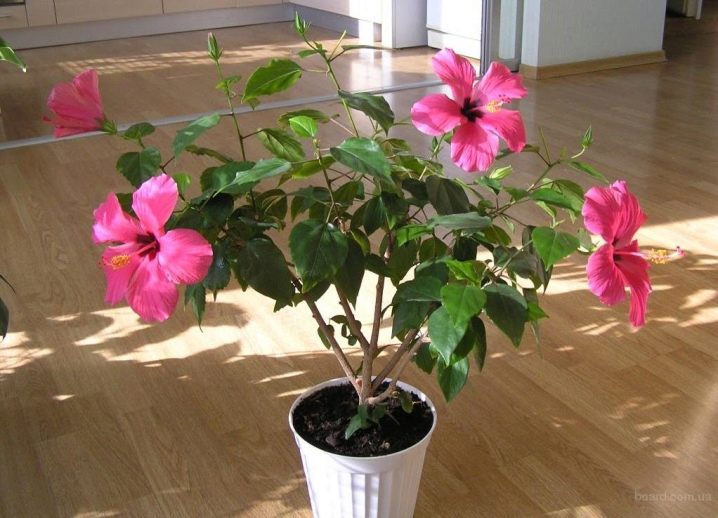
For information on how to properly care for indoor hibiscus, see the next video.




























The comment was sent successfully.